The NEMO Mayfly OSMO 2-Person Tent is a semi-freestanding, lightweight backpacking tent with a heavy-duty floor. Sized for two, it’s also suitable for solo hikers who want to bring their dog or camp on rough surfaces without bringing a separate footprint. The Mayfly pitches quickly and has many useful details that increase livability and make it easy to use while being priced somewhat less than NEMO’s other premium tent models.
Specs at a Glance
- Minimum Weight (manufacturer’s): 3 pounds, 0 oz.
- Minimum Weight (tested): 3 pounds, 1.1 oz. This includes the fly, inner tent, and poles.
- Total Packed Weight (manufacturer’s): 3 pounds, 8 oz.
- Total Packed Weight (tested): 3 pounds, 9.1 oz: This includes the fly, inner tent, poles, 8 stakes, tent pole repair sleeve, extra guyline, stake sack, pole sack, and “Divvy Sack” (tent stuff sack).
- Floor Dimensions (manufacturer): 85 X 52/43 inches
- Floor Dimensions (tested): 85 x 52/42.5 inches
- Peak height (manufacturer): 42 inches
- Peak height (tested): 41 inches
- Vestibule area (manufacturer): 7.1 square feet per vestibule
- Fly material: NEMO OSMO fabric, seam-taped
- Tent material: 68D PU-coated polyester bathtub floor, white and black noseeum netting
- Poles: DAC Aluminum poles with hub
Semi-Freestanding Design
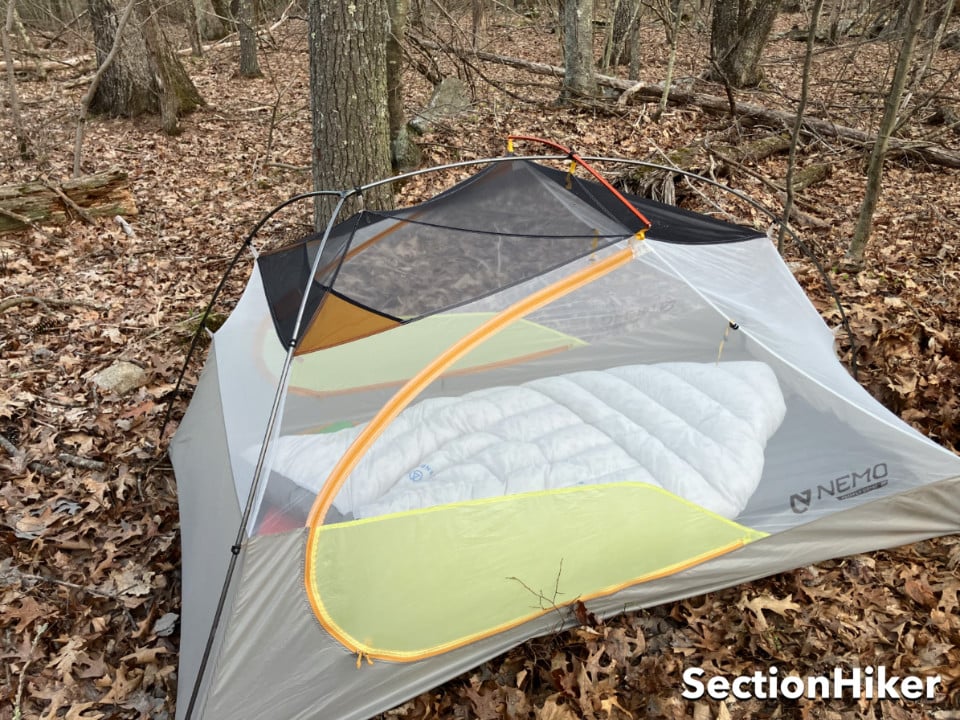
The main benefits of a semi-freestanding tent over a freestanding tent are weight savings from the reduced pole set and smaller packing size (see our FAQS on semi-freestanding tents and freestanding tents). The main cons of semi-freestanding tents are that one end relies on being staked out to hold the shape of the interior, so you can’t pick it up to move it around, and it’s not as easy to pitch on a tent platform.
Fabric and Stakes
NEMO uses its proprietary OSMO fabric on the Mayfly, a mix of polyester and nylon with the benefits of each (durability for nylon, sag resistance for polyester). In my testing, I was impressed by how taut the OSMO fabric stayed overnight and in wet conditions, notably different from my experience with nylon tents and tarps.

NEMO no longer publishes fabric denier information except to note the robustness of their heavier-weight floors (68 denier), so we can’t speak to the specs of the OSMO fly, the solid fabric on the bottom half of the doors, or the mesh. As is typical for NEMO tents, white mesh is used on the sides and black mesh on the roof to provide better visibility for stargazing.
On the other tents I’ve used from NEMO, the floors were PeU-coated (polyether urethane), which doesn’t hydrolyze (break down and become sticky and smelly, especially in storage) as PU (polyurethane) coatings can. However, on the Mayfly, NEMO has gone to a PU floor. While PU is less expensive than PeU, if you’ve ever had a PU floor breakdown, you understand why it’s called PU. This is a step backward to lower quality, in my opinion. Here’s an in-depth comparison of the two coatings.
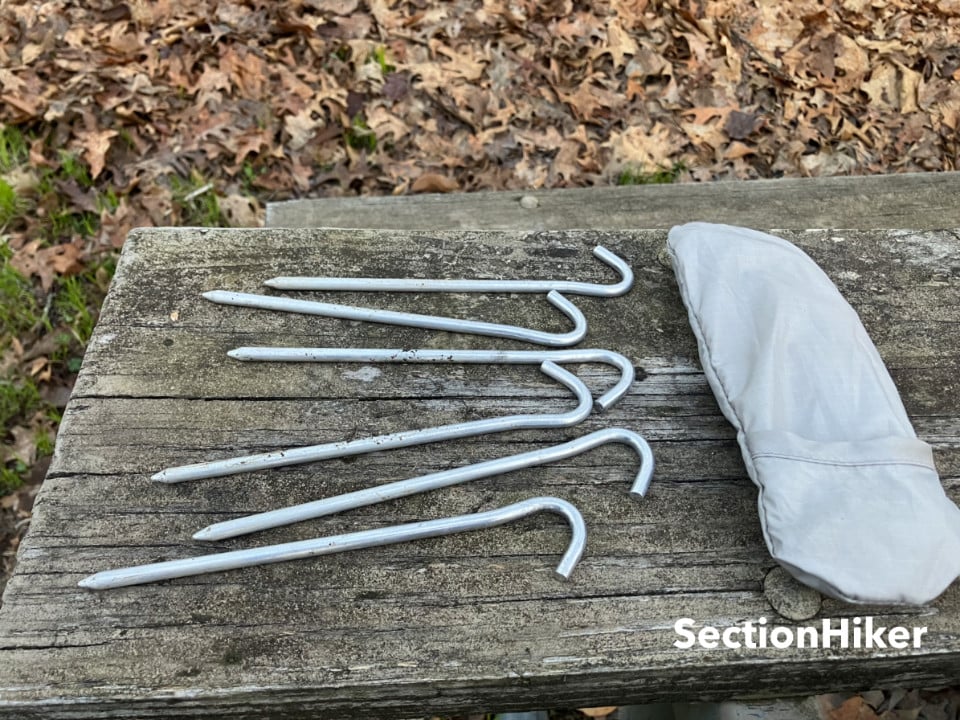
NEMO’s other tents also come with good stakes–tough aluminum Y-shaped stakes with an upside-down J-shaped cutout to hold the guidelines securely. However, the Mayfly comes with aluminum shepherd’s hook stakes–the kind that comes with a car-camping tent from a big-box store. So, a couple of budget decisions have been made with the Mayfly, but at $400, this is not a budget tent.
Tent Setup
The Mayfly has a simple setup that can be done quickly with little practice. Spread out the inner tent. Connect the main pole segments together into a big Y shape, and insert the two arms of the Y into the Jake’s feet on the inner tent. Arc the pole over the top and clip the tail of the Y into the grommet at the foot end. Clip all of the clips of the inner tent to the main pole. Attach the crossbar over the top of the other pole, and clip the color-matched clip to it. Stake out the head and foot end, pulling the fixed guylines to make the foot end taut, with the pole struts at either corner standing up straight. Next comes the fly.

At the head end, the fly attaches to metal Jake’s feet with some unique hardware. The fly has a tensioner piece that looks like a key on a piece of grosgrain ribbon, and the Jake’s foot has a keyhole. Put the key in the hole and turn it 90 degrees to lock it in place.
I quickly learned that if I tried to connect the head end of the fly first, the lack of tension in the fly meant that the keys kept twisting and popping out of the keyholes as I moved from one side of the tent to the other. But if you connect the foot end of the fly first, slipping the guylines over the same stakes holding up the foot end of the inner tent, then connecting the loops at the apex of the fly to the crossbar, and then finally attaching the head-end hardware, the fly is under enough tension that the keys hold tightly in their keyholes. Of course, this is all easier if you have two people to set up the tent and not just one.
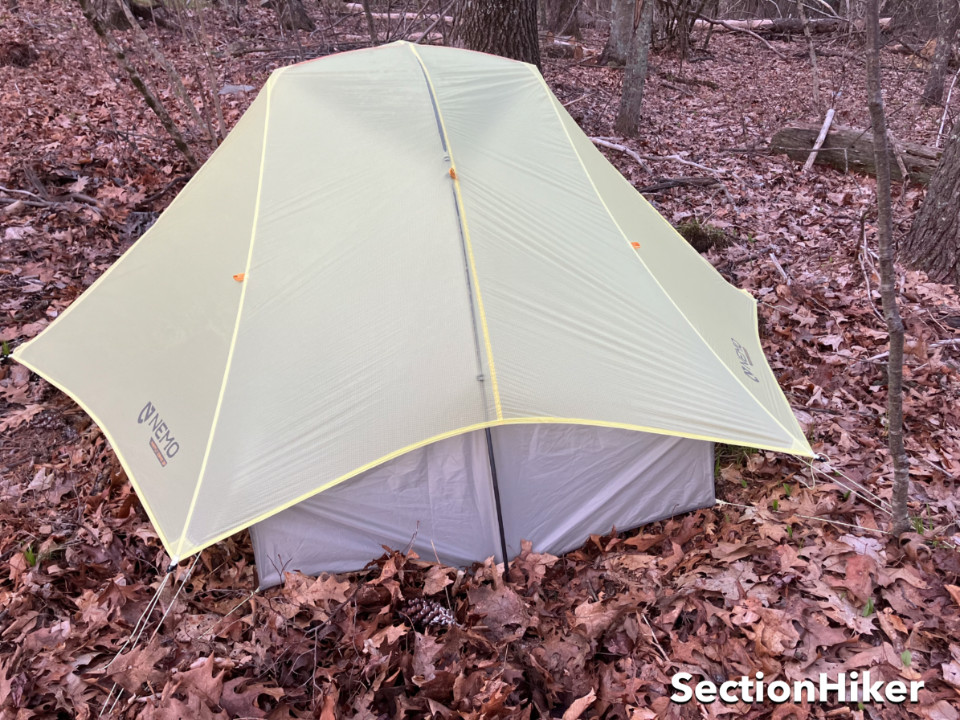
Ventilation
Ventilation is this tent’s strong suit. One night, I used it. It was 40*F with wind gusts of up to 20 mph, and I could feel the breeze on my face while lying down. The vestibules don’t come down to the ground; they are catenary cut to help maintain tautness and fresh air intake. While there are solid fabric strips along the tent’s length above the bathtub floor (before the mesh begins), these serve more as privacy panels than as windblocks.
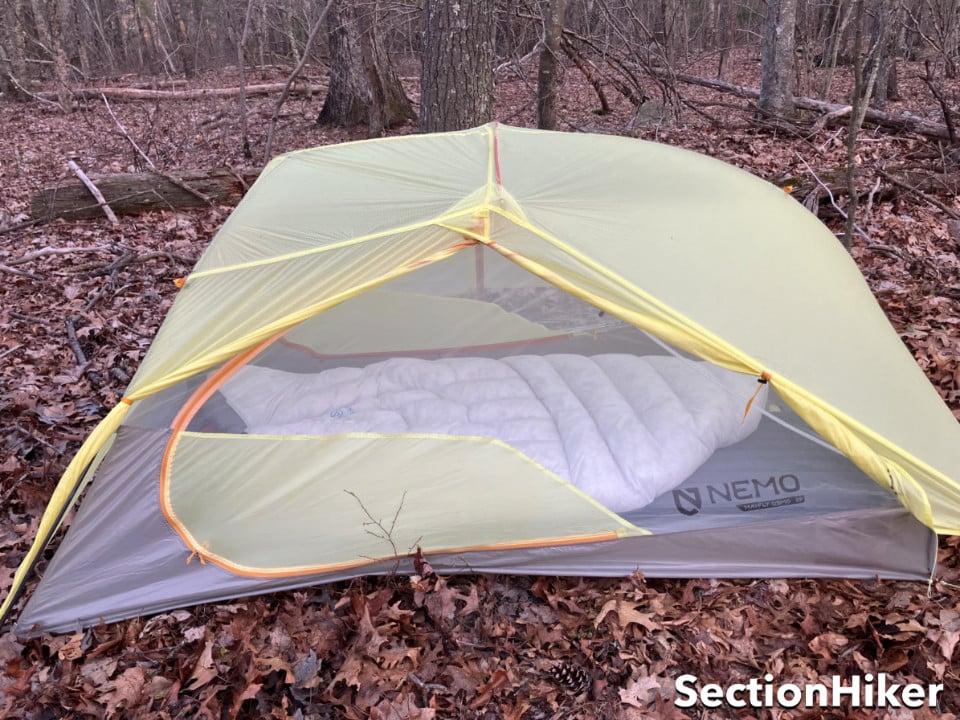
There is also a scooped cutout of the fly at the head end, NEMO’s signature, but this one is more subtle. You can guy it out to increase the space between the inner and the fly to get even more air exchange into the tent. The vestibules have two-way zippers and kickstand vents so you can unzip them from the top and prop them open for moist air to escape while still getting weather protection from the rest of the vestibule being zipped up.
The ventilation features make the Mayfly perform very well on warmer nights and help prevent condensation on rainy ones. But precisely because the airflow is so good, it is not a tent I would take deep into the shoulder seasons. Also, one night, I set it up in the rain, and overnight, the temps dropped below freezing. Both vestibule zippers froze shut even though there was a sizable storm flap covering the zippers.
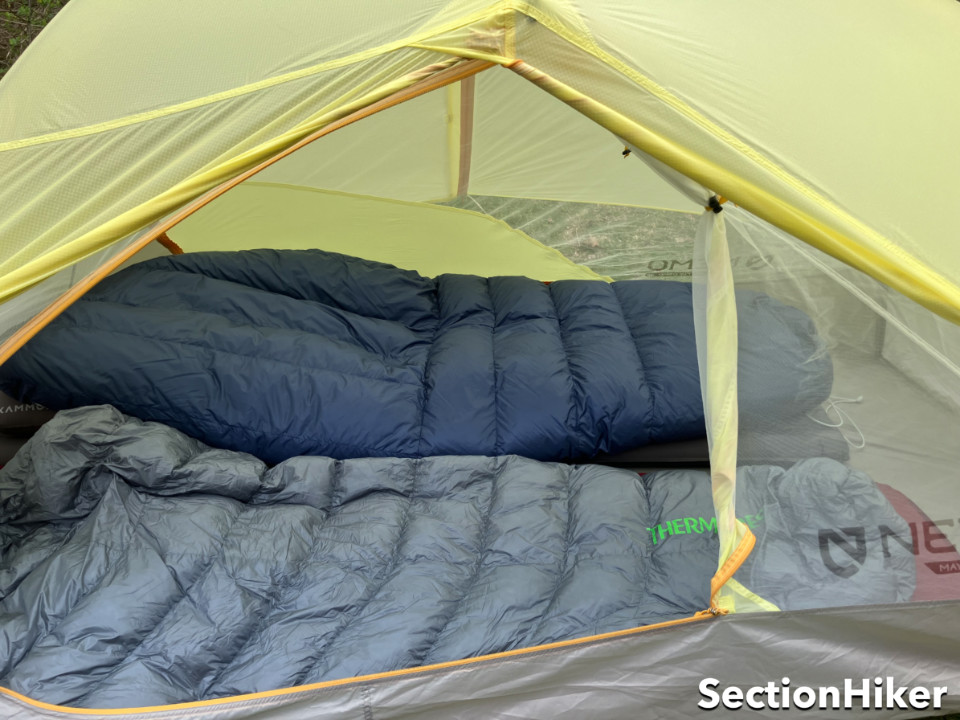
Tent Storage
The Mayfly’s main stuff sack is rectangular shaped for packability and has a rolltop closure. The name “Divvy Sack” for this stuff sack has stuck from the previous design, based on the idea that you can either pack the tent and poles together into an 18-inch long package or split the weight between two hikers, with one taking the poles and the other one taking the tent and fly. With the poles removed, you can compress the tent sack to about 13 inches long by rolling the roll top.
NEMO has done away with the standard drawstring and cordlock closure on the stake and pole bags in favor of an envelope construction that works like non-zip sandwich bags–you fold over the top to lock in the contents. It’s lighter weight and has nothing to break, but it is a little trickier to use with cold hands or when wearing gloves.
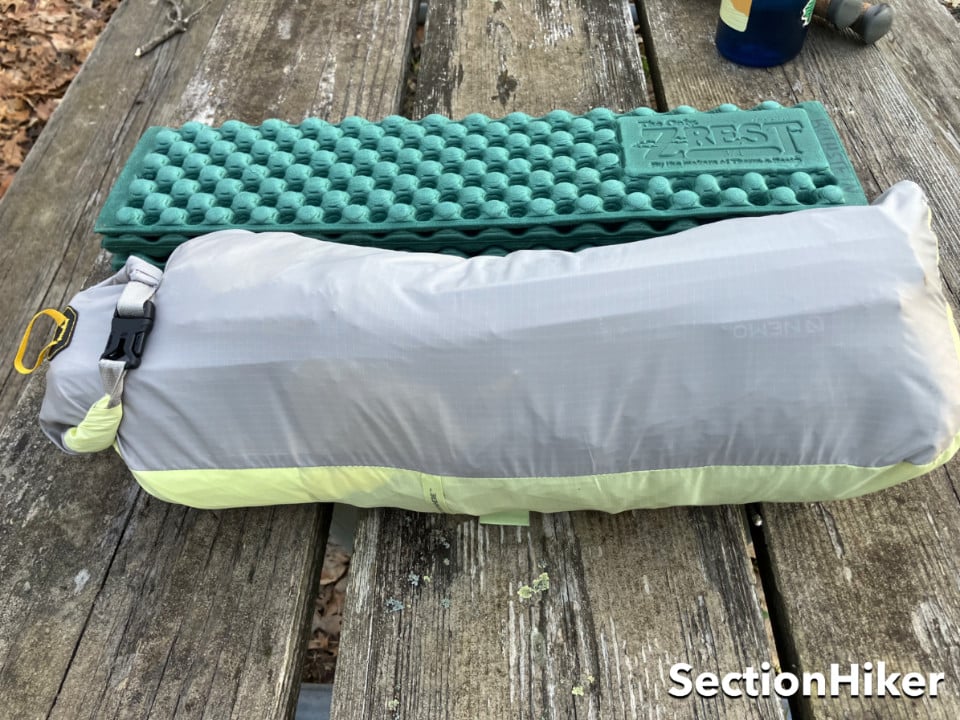
Two Person Features
The Mayfly 2P is a comfortable tent for one person and a cozy fit for two people, with extra room at the head and foot ends for some of their gear and some other storage features I detail below. Each person has a C-shaped door, meaning no one has to climb over the other person to exit the tent and their vestibule, where they can store their backpack, shoes, and water. Because the floor tapers down to 42”, if you are sharing the tent, neither of you can use 25” wide pads, which are becoming more and more popular.

Notable Convenience Features
NEMO is very good at including little details and features that make their tents easy to set up, fun to use, and very livable. Here are some of those design elements on the Mayfly:
- Gatekeepers: A quick-stow feature for rolling up the vestibule’s head end and the inner tent doors on both sides. A little plastic two-pronged hook captures a cord lock on a grosgrain ribbon. It is the fastest, easiest system I’ve ever used to keep a tent door open, and you can operate it with gloves on.
- Yellow light-diffusing headlamp pockets: Found at either side of the tent’s head (one for each person). They cast a warm yellow glow that lights up the tent and that you can read by while lying down.
- Gear loft: A triangle of tensioned mesh fabric at the tent’s peak is a good place to store bulkier (but still lightweight) gear off the floor and keep it easily accessible. I learned that when you put a down jacket up there, it may be damp with condensation from the warm, moist air that rises to the top of the tent at night.
- Gear loops: There are 7 small grosgrain loops, including one at the center peak that opens with a snap, around the ceiling for hanging glasses, small items from a mini carabiner, or a clothesline.
- Phone/ Glasses pocket: A small, horizontal mesh pocket near the peak at the head end between the headlamp pockets keeps fragile items from getting crushed or bumped.
- Colored crossbar: This is a small pole, but it’s colored bright orange to make it hard to lose during setup.
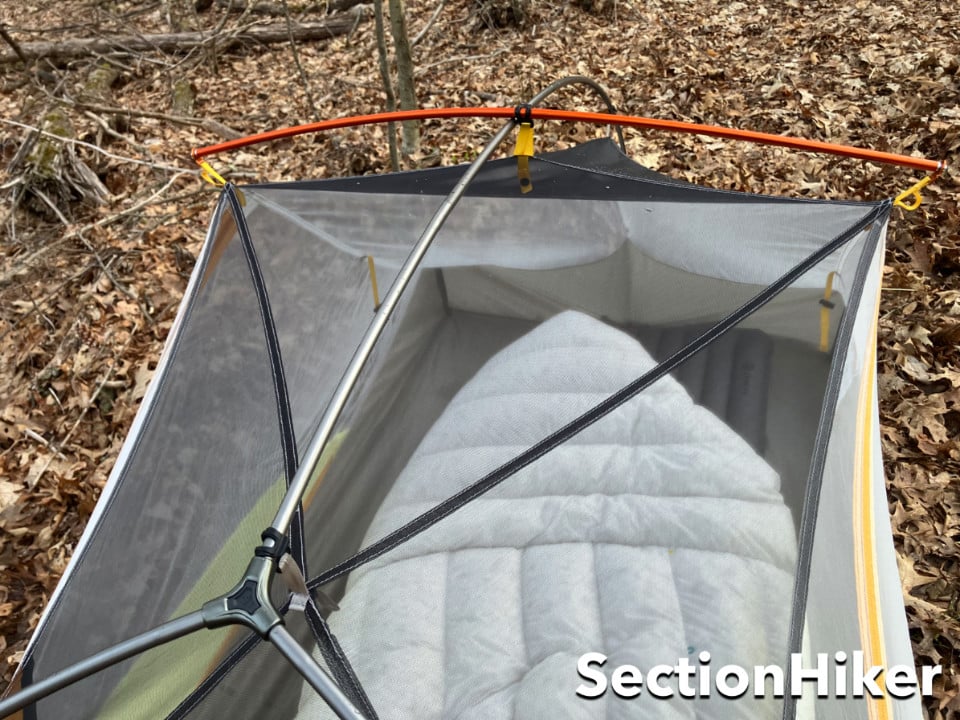
Recommendation
The NEMO Mayfly OSMO 2 is a mid-price lightweight camping and backpacking tent for two people. It’s well-ventilated and easy to set up with a semi-freestanding design that has two doors and two vestibules. The Mayfly is made with NEMO’s hybrid OSMO fabric, which does not sag when wet. Numerous gear storage options in the interior make it convenient to use while a thick and durable tent floor makes it suitable for camping with a dog or on abrasive surfaces without the need for an additional tent footprint.
Likes:
- Super easy, intuitive setup
- OSMO fabric stays taut
- Burly floor is good for rough ground or camping with a dog
Dislikes
- The choice to use a PU floor instead of PeU
- Cheap stakes
Disclosure: NEMO donated a tent for an impartial review.
About the author
Greg Pehrson is an ultralight backpacker who was bitten hard by the MYOG (make-your-own-gear) bug. He repairs, tinkers, and builds gear, often seeking to upcycle throwaway items or repurpose things from outside the backpacking world.
